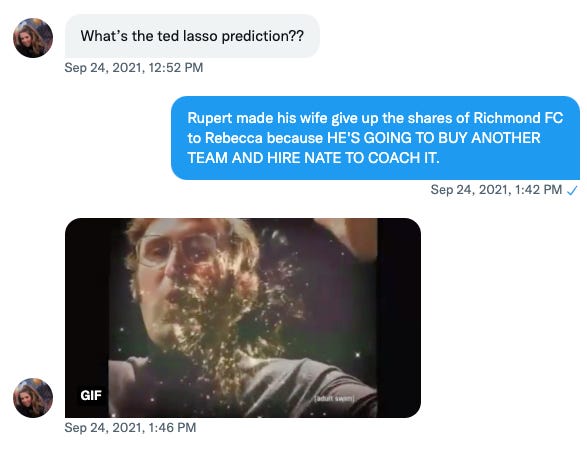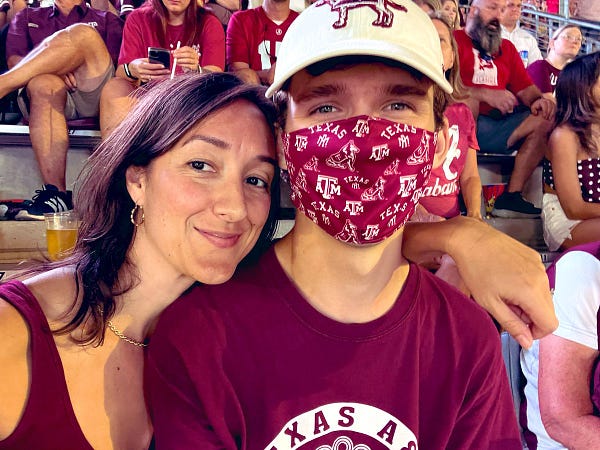What is really, really at the end of the road?
I spent Hate Week looking for good news.
Welcome to The Experiment, where we’re sorry we didn’t get you a fresh newsletter last weekend, but y’all we were busy, and today we’re explaining what was up. Also, Jack Hughes recounts the truly bizarre pop culture roots of the trillion-dollar coin idea. Seriously bonkers stuff, people.
And as always, we recommend things to do (forget the Alamo at Zilker Park on Oct. 22), read (this gorgeous piece about traveling to Spokane, Washington — really), watch (Hulu’s Only Murders in the Building), and listen to (Shad’s “The Old Prince Still Lives at Home.”) And there are a bunch of ways to support this newsletter, such as dropping a tip into the Venmo or PayPal buckets, buying merch, or, if you’re new here, subscribing.
But first, have you ever heard about Hate Week?
Hate Week started as an event in George Orwell’s Nineteen Eighty-Four in which the party in charge whips the populace into a frothy antipathy toward the other party, and has become, as many things do, an excuse to sell diet beer on television. Hate Week now refers to an actual event in which some college football teams play their most-hated rivals. In Texas, this means an entire week of answering questions about what time it is with, “It’s 2:30, and OU still sucks.”
My Hate Week started with a school shooting, not where I work but where I was going. Bryan and I had a speaking gig up at a community college in Arlington between Dallas and Fort Worth. We arrived shortly after a lockdown order had been lifted at all area schools. It seems the gunman, or gun boy, really, had turned himself in after shooting four classmates in a fight. Because students had videoed the fight and posted it on social media, the shooting made international news while Bryan and I were driving north. Because the college offered dual credit classes with that high school, they had faculty on campus. During what was supposed to be a pre-talk social hour, the college faculty and administrators processed the events of the day, mostly ignoring us. And then we all went downstairs and talked about 200 or so people dying in armed conflict at the Alamo.
The next morning we got an early start back to Austin. The school district’s chief of police (for Austin, not Arlington) called me shortly after 7 to say that a kid had made a threat on Instagram to bring a gun to Austin High School and shoot all the Black kids. The thing was, so many schools in Texas are named after Stephen F. Austin that they couldn’t be sure the Austin High being threatened was ours, which it turned out it wasn’t.
Hate week was off to a heckuva start.

On the drive down I saw an old friend tweet that Republicans are more likely to hold Donald Trump above criticism within the Republican Party than Christians are to believe in the inerrancy of the Bible. Say what you will about biblical literalism, but Jesus never told his disciples to ignore subpoenas.
That night S and I had drinks with a political friend from out-of-town. We sat at a bar; she and S talked politics, while I watched my Seahawks struggle against the Rams. The thing is, the Seahawks never lost on Thursdays when they played at home. And they had Russell Wilson, who was on his way to a historically good season.
“Who are we rooting for?” she asked. I mumbled something about the Seahawks, partly out of embarrassment for their day glow highlighter uniforms but mostly because of the score.
“You’re not a big fan, are you?” S cautioned that I was, so our friend returned to talking about politics. To be fair, by that point our political situation at least had a chance to work out well, because right then Wilson whacked his hand against an opposing player’s helmet, though to be fair it didn’t matter whom the helmet belonged to because one of Wilson’s fingers was bent wrong.
That’s when my favorite thing in the game happened. This might be my favorite thing in any game, as I am a connoisseur of chaos. The Seahawks punted twice on one play.
With everything falling apart around him, Michael Dickson playfully headed back out there to do his job. As he received the snap and readied his kick, a Rams defender came flying up the middle. He blocked the punt, sending the ball spinning off to the left. No matter, like a modern-day Tom Bombadil— unphased as he giggles and dances his way through a world of torment and chaos— Dickson bounded over and scooped up the ball with one hand like a fucking maniac.
At this point the game had basically become Calvinball and, in the absence of rules, Dickson did what he does best. After palming the pigskin, he darted around like he was gonna run for it before pulling up and launching a (I can’t believe I’m saying this) 68-yard punt while everything else descended into madness. Absolutely no one knew what the rules were at this point, and Dickson sat off to the side laughing and writing ditties about magic while refs threw flags, picked them up, discussed their options, and ultimately let the play stand.
This play is why I love sports. The rest of the game is why I hate sports.
“It’s times like this that I find it useful to remind myself that I don’t play for the Seahawks,” I told our friend. She had just told S about having to suppress tears of impotent rage when interviewing the Republican sponsor of the law that outlawed abortion before most women know they are pregnant. I don’t think she was listening to me rationalize football.
***
Friday had a chance to redeem Hate Week, for as is well known to those who observe, Fridays are Ted Lasso Day, and last Friday was the season finale, the episode where the writers would tie all the loose ends together and hang us over a cliff until next season. But more importantly, Friday was the day I would find out if my big prediction was right. So I woke S up early like it was Christmas morning, and we watched the show before the sun rose.
Long story short, when Rupert (total prick billionaire) gave back his shares in the team to Rebecca and whispered in the ear of Nate (underdog rapidly turning into a heel), I predicted that Rupert would buy a competing club and steal Nate away to coach against his old team. This is, for the record, exactly what happened.
And yet, I am not pleased. The point of this whole season has been to get at why Ted Lasso resisted therapy and had a panic attack during a game, which as readers of The Experiment know is because Ted, who has abandonment issues, abandoned his son in Kansas to coach a soccer team in London. There were tons of bread crumbs — the picture of his son on his lock screen, Nate accusing him of abandoning his son — leading us to the post-match press conference when Ted could finally have his say, and then this drivel comes out of his mouth.
Or rather, I want to share with y'all the truth about my recent struggles with anxiety. And, well, my overall concern about the way we discuss and deal with mental health in athletics.
This is like saying that the big hurdle Odysseus had to overcome was navigation, or that the problem with breast cancer is a lack of awareness. Yes, we can all agree that breast cancer is bad and that mammograms are good, but don’t we already know that? We can raise awareness about “the way we discuss and deal with mental health in athletics” all we want, but none of that advances the Ted Lasso narrative about why he freaked out. S thinks they’ve set up a third-season story arch for Ted; I think the writers failed to raise the stakes and instead took the coward’s way out. Hate Week continues thusly.
Also, Jamie was offsides. Obviously.
As we got ready for the day, S noticed the ProPublica piece that for years children had been jailed in a Tennessee County for a crime that did not exist in statute. They just made it up. I countered with Texas Monthly’s story about a county district clerk who made a practice of separating jurors by race before assigning them to trials.
“Isn’t anyone accountable anymore?” she asked.
No. Not even Jamie Tartt. I mean, he was offsides. Obviously.
***
Nothing says Hate Week like spending time with family. On Saturday, S and I had a lazy morning before heading to College Station to see the Alabama game with the Elder Son while the Texas-OU game played out on Twitter like a crowd-sourced emotional EKG. By the time we stopped in Caldwell for some Whataburger, young people wearing Alabama T-shirts were asking each other if they’d seen the Longhorns blow it.
I feared we were headed for worse. At least Texas dangled a win in front of their fans before dropping it into the soup. Texas A&M was a 17-1/2 point underdog to a team that had won a hundred straight games against unranked opponents. On a shuttle bus from the parking lot to Kyle Field, S asked a mother of an adorable son sitting on her lap whether it was his first game. “He’s been to a lot of games,” she said confidently. And then, less so, she said, “They’ve never lost when he’s there.” Her words shut down any conversation. No one even suggested the possibility of an upset against a team on a 19-game winning streak. Since 2008, the top-ranked team had beaten unranked teams 106 times in a row. I looked at the chubby tyke and shrugged. Best he learns to deal with disappointment sooner rather than later, I guessed, but the dumb kid just beamed as he grabbed a silver pole. “This is his first time on a bus,” his mother said.
This was our first time at Kyle Field, a strange place full of odd customs. There was a flyover in missing man formation. There was a prayer to a Christian god. “I feel like I’m in a foreign country,” said S.
Then came the ritual yelling encoded with gestures that everybody but S, me, and the Alabama fans were privy to. No one had to put crowd cues or song lyrics on the Jumbotron. We only thought we were going to a football game; this was church. “Are they playing a football game?” asked S. “I haven’t seen this much crowd interaction since the Blue Man Group in Vegas. Seriously, this is like when the acid kicked in at that Widespread Panic show I went to.”

And that’s when things got weird. Amid the ritualized yelling, cadets appearing quite fit in their tight brown uniforms and closely cropped haircuts lined either side of the tunnel leading from inside the stadium onto the field, creating two parallel lines. At the base of each line stood large black boxes. Then the flag girls came out and quietly extended the cadets’ lines, extending the shaft farther into the field. At some point another fit, uniformed young man gently led a pretty collie between the two lines before a great rush of hulking men came shooting out of the stadium, through the tunnel, and out into the open air as explosive spurts of fire came pulsing out of the black boxes and 106,815 people went nuts.
The martial pageantry had a distinct homoerotic paramilitary vibe. I have been to a Trixie Mattel show, and the Aggie pregame show might have been the gayest thing I’ve ever seen. Cher would have asked Coach Jimbo Fisher if this all weren’t a little much. It was awesome.


Like the Longhorn game, it started great and got tense. The Alabama fans behind us crowed as their squad began asserting their dominance. I tried to remind myself that I was not emotionally invested in this game and was only here to spend time with the Elder. And that’s when the students began chanting “Fuck Joe B*den.”
“This happens at every game,” said the Elder. But no sooner did the chant start than the Yell Leader, which is what they call Head Cheerleader in a triumph of rhetorical overcompensation, roused the Corps into a traditional chant, the first four words of which were, I kid you not, “rah.”
The Aggies’ defense bent twice, holding the Crimson Tide to two fourth-quarter field goals before breaking, giving up a touchdown, a two-point conversion, and the lead. Somehow the Aggies drove down the field for a touchdown to tie the score, and when the defense forced an Alabama punt, the Aggies had the ball with 2:07 left, at which point S and I realized that the little boy on the bus had never been to an Aggie loss.
The crowd held it together until Seth Small, a 5’11” kicker from Katy jogged out to attempt a game-winning field goal as time expired. Small later ranked the moment as the third-best in his life behind accepting Jesus as his savior and marrying his wife, pictured below. (You’re gonna wanna watch this.)

I have never beheld a mass expression of joy like I felt at Kyle Field as the fans poured out of the stands. We stood there with dumb smiles on our faces and watched the happy bedlam. We turned around and noted the stunned expressions on the faces of Alabama fans before telling them good game and walking back to the car.
The next morning was Sunday. We had survived Hate Week. S and I drove home, stopping for breakfast in Caldwell where we saw a white chicken cross the road. We were in a hurry to get home—her for a chess lesson, me for ACL Fest with the Younger—and had no time to ask the chicken why. This was my first music festival since the pandemic and the first event I’d had to show proof of vaccination (or a clean test result) to gain entry.
Zilker Park which hosts ACL Fest was a mirror image of Kyle Field. Despite the vaccination requirements, many had stayed away after not being able to resell their tickets. I got a third Pfizer shot from a nursing station that was giving shots away for free. Several artists, most notably Billie Eillish, dropped F-bombs on Texas Governor Greg Abbott to big cheers from the Austin crowd.
I’d gotten there early before the Younger had woken up to see BLK Odyssy, an Austin jazz-rock-hiphop group, but I was really there to see Noga Erez, an Israeli singer who looks and sounds like St. Vincent and David Byrne’s love child. Or maybe Björk and Kendrick Lamar. Or M.I.A. and Frank Ocean. Like BLK Odyssy, she had embraced Gen Z’s favorite trend, genre-nonconformity. Her sound is electro-hip-pop with a side of EDM.
I featured Erez back in March because I was taken as much with her hit “End of the Road” as the video in which she march dances on top of a treadmill of sorts while senior citizens observe her from a safe distance. Why old people? Because this song is full of ambition running through limits but up against mortality. The limitations imposed by the pandemic turned necessities into creative opportunities.
I pardon no one, nobody
Chop, chop, chop it right hand
Chop it like a pickpocket
You had the mic, now you can't drop it
Dumb, dumb, dummy
Once nobody I'm coming
I'm coming, I'm coming, sit down
Only a couple hundred showed up for Erez’s 2:15 showtime on a small stage, but she could not have been happier. After prattling on between songs that she was speechless at being on her first US tour, she introduced “End of the Road.”
“We wrote it from a really, really sad place, and it’s the song people like dancing to the most,” she said.
Lately, I got ceilings but I burn in the sun
I never miss one shot, I'm sick as a gun
I got mortal friends, I'm dead as they come like
Hey! I'm on the way!
We’ve spent a lot of time since March 11, 2020, wondering when things would get back to normal. But as my friend R.H. observed, this—the masks, the precautions, the risk calculations—is what we do every day. And what we do every day is our normal. This, the bad coexisting with the good, “fuck Joe Biden” with the joy of upsetting Alabama, “fuck Greg Abbott” with the catharsis of live music, is what is next. The end of this pandemic will not mean that whatever follows will be the raw, unfiltered honey of good times.
Hate Week ends, but we keep going, alternately shouting imprecations against the President or the Governor, cheering together the next. We are living in genre-nonconforming times, but we resist the obvious truth that we are stuck with each other. We are stuck with them, and they with us, and us all with ourselves. I don’t know what really, really happens at the end of the road, just that the chicken will probably cross the road at some point, and we’ll never know why.
I don't know what really, really happens at the end of the road
I don't know what really, really happens at the end of the road
I don't know what really, really happens at the end of the road
(Maybe nothing)
But my trip is mad
I ain't finished, I got loads
Jason Stanford is the co-author of NYT-best selling Forget the Alamo: The Rise and Fall of an American Myth. His bylines have appeared in the Washington Post, Time, and Texas Monthly, among others. Follow him on Twitter @JasStanford.
Más
How we’re getting through this
Endorsing this
Subscribing for free to Axios Austin
Preordering Keri Blakinger’s memoir
Taking this as a sign of progress, I think
Forgetting the Alamo at Austin’s Zilker Park
Making seared scallops with jammy cherry tomatoes
What I’m reading
Robert Kolker: “Who Is the Bad Art Friend?” - This, the article that made writers Twitter explodey, is worth the ride.
There is a sunny earnestness to Dawn Dorland, an un-self-conscious openness that endears her to some people and that others have found to be a little extra. Her friends call her a “feeler”: openhearted and eager, pressing to make connections with others even as, in many instances, she feels like an outsider. An essayist and aspiring novelist who has taught writing classes in Los Angeles, she is the sort of writer who, in one authorial mission statement, declares her faith in the power of fiction to “share truth,” to heal trauma, to build bridges. (“I’m compelled at funerals to shake hands with the dusty men who dig our graves,” she has written.) She is known for signing off her emails not with “All best” or “Sincerely,” but “Kindly.”
Francie Latour: “New England’s Hidden History” - I mean, damn.
“A mentor of mine has said New England really democratized slavery,” said Farrow. “Where in the South a few people owned so many slaves, here in the North, many people owned a few. There was a widespread ownership of black people.”
Jon Mooallem: “I Had a Chance to Travel Anywhere. Why Did I Pick Spokane?” - It’s a good ride, but oh, how he lands this plane…
Then, as if I’d won a sweepstakes, this magazine offered me the seemingly wide-open opportunity to fly somewhere for its travel issue. By then, I’d spent almost 17 months parenting two demanding children on an insular island. I needed to get back to work. And so, I considered the befuddling risks, stresses, uncertainties, child care complications, psychic agitations and relative irresponsibility of traveling anywhere at all and asked, “What if I drove to Spokane?”
What I’m watching
Do you know how bad Steve Martin would have to be in Only Murders in the Building, Hulu’s satire of true-crime podcasts, for me not to watch it? Luckily, the satire leaves a clean bite. I love it.
What I’m listening to
This one’s for the hostess with the mostess; “It’s Bad You Know” by R.L. Burnside is good stuff.
That led me to “All Bad (feat. Anderson .Paak) from Nas.
I have no idea how I ran across “Lucky Penny” by J.D. McPherson, but I’m glad I did.
Let’s slow it way, way down for Prateek Kuhad with “cold/mess,” a sad song about longing. “I wish I could leave you my love/But my heart is a mess.”
I’m new to Shad, and that’s on me. “The Old Prince Still Lives At Home” is a good place to start.
We’re going to end with the song that capped the second season of Ted Lasso — “yankee and the brave” from Run The Jewels.
What do you think of today's email? I'd love to hear your thoughts, questions and feedback. I might even put ‘em in the newsletter if I don’t steal it outright.
Enjoying this newsletter? Forward to a friend! They can sign up here. Unless of course you were forwarded this email, in which case you should…
Thanks to Noom, I lost 40 pounds and have kept it off for more than a year. Click on the blue box to get 20% off. Seriously, this works. No, this isn’t an ad. Yes, I really lost all that weight with Noom.
We set up a merch table in the back where you can get T-shirts, coffee mugs, and even tote bags now. Show the world that you’re part of The Experiment.
We’ve also got a tip jar, and I promise to waste every cent you give me on having fun, because writing this newsletter for you is some
Buy the book Texas Lt. Gov. Dan Patrick banned from the Bullock Texas History Museum: Forget the Alamo: The Rise and Fall of the American Myth by Bryan Burrough, Chris Tomlinson, and myself is out from Penguin Random House.







